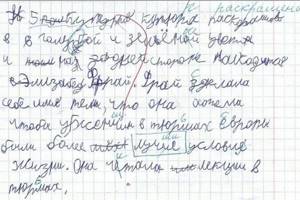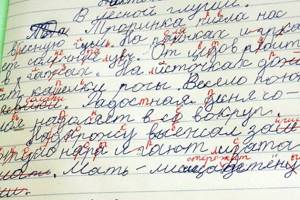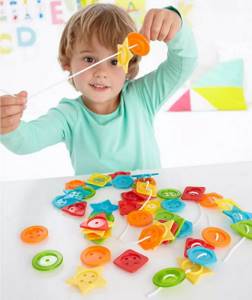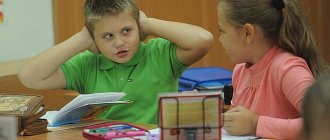Poor handwriting in a child can cause poor performance at school: according to assessment criteria developed by the Ministry of Education, primary school teachers are required to reduce grades for clumsy lines. If the problem is not solved in first grade, it will only get worse. In the end, the child may begin to write completely unreadable text that even he himself cannot decipher.
There are certain exercises to improve your handwriting. By completing them, the child will gradually learn to write beautifully and correctly. You shouldn’t rely only on school teachers. Improving writing technique is a joint work of teacher, student and parents.
Causes of problems with writing
In most cases, errors appear in the first grade: the child writes dirty, goes beyond the margins, confuses uppercase and lowercase letters, and does not complete them completely. What is this connected with? Writing is a complex process in which several parts of the brain are involved: speech and motor centers, memory, logical thinking, imagination, and auditory center. In order to correctly write a particular word, you must:
- Correctly hear the word and identify individual sounds in it.
- Restore in memory the letters that correspond to them.
- Figure out how they are spelled correctly.
- Give the desired command to your hand.
- Remember the rule, if necessary, and apply it.
A child makes mistakes if at some point the connection between parts of the brain is interrupted, despite the fact that he has been preparing for the lesson all evening.
First of all, such phenomena are associated with a lag in speech and psycho-speech development in the preschool period:
- started speaking later than his peers;
- does not know how to play role-playing games;
- has difficulty learning the rules of simple games, such as hide and seek;
- speech is incoherent, incomprehensible;
- there are difficulties in communicating with peers and adults;
- the appearance of sounds does not correspond to the age norm.
If the child was seen by a speech therapist before entering school, special attention should be paid to the prevention of dysgraphia.
Why does dysgraphia develop?
Dysgraphia is a disorder of the written speech process that occurs due to unformed higher mental functions. As a result, the child is unable to master proper writing and language grammar. According to speech therapists, the causes of dysgraphia can be divided into several large groups.
- Biological: central nervous system lesions, heredity, difficult pregnancy, birth trauma, severe infections, brain injuries.
- Social and psychological: long stay in the hospital, pedagogical neglect, lack of communication, two or more languages are used in the family.
- Environmental and social reasons: adults place too high demands on academic performance, the child was sent to school too early, methods are too harsh and the pace of learning is too fast.
Most often, dysgraphia develops in children with hearing or vision impairments; their brains cannot correctly analyze and synthesize information. According to statistics, dysgraphia is detected in almost a third of Russian primary schoolchildren.
The following signs indicate that a child has developed dysgraphia:
- he makes mistakes even in cases where the choice of letter is obvious, for example, under stress;
- misses one or more letters;
- mixes similar sounds: vedka - branch, awkward - clumsy;
- does not complete individual letters, syllables, endings: soba - dog;
- rearranges syllables and letters: bubashka - babushka;
- repeats similar-sounding letters: magazim - store;
- writes some letters and numbers upside down, mirrored;
- skips letters that are rarely used: ь, е, ъ;
- writes sloppily, dirty, the lines dance, there are no margins;
- does not know how to break words, does not leave spaces between words;
- cannot determine the boundaries of a sentence, does not use periods or capital letters.
A speech therapist can make a diagnosis of dysgraphia, so do not ignore the teacher’s comments and requests to show the child to a specialist. The sooner you start the correction, the more successful it will be.
Why does a child’s bad handwriting need to be corrected?
Poor handwriting has consequences if the child is not homeschooled. Unpleasant statements from teachers and peers are possible, leading to self-doubt, which in turn interferes with the development of potential.
In addition, the student, knowing about his problem, does not like important subjects that require writing skills, for example, Russian, biology, geography. A constant state of discomfort can significantly affect the future; a child can choose a profession only based on how many written exams he will have to take.
Some experts working with difficult children advise starting with improving handwriting; if it becomes more accurate, then behavior changes for the better, because the skill requires concentration, perseverance and patience. Illegible handwriting reduces academic performance because teachers cannot interpret letters or numbers correctly, and a literate child ends up receiving a bad grade.
As you can see, it is necessary to improve handwriting not only because it is a requirement of an educational institution.
How to help a child with dysgraphia?
Be sure to see a speech therapist
He will conduct an interview, perform functional tests, refer you for functional diagnostics if necessary, and give you detailed recommendations on how to organize classes at school and at home.
Enroll your child in a sports section
Playing sports, like writing, requires the coordinated work of several parts of the brain at once. Sports games teach children to follow rules and interact with other children. Outdoor games are especially useful: thanks to deep breathing, the brain receives more oxygen than usual.
Develop fine motor skills
Modeling, drawing, putting together puzzles - any activity that requires small finger movements is suitable. Speech therapists advise buying pencils, pens, felt-tip pens with an unusual body surface, for example, raised dots, so that during writing and drawing, the inside of the palm and fingertips are continuously massaged, ensuring better blood flow to the speech center.
Massage your baby's head and neck
Use light massage movements to work on the cervical and occipital parts of the child’s head when he comes home from school. This will help relax tense neck muscles that compress blood vessels and improve local blood supply.
Study Russian additionally
Complete tasks to master vocabulary, grammar, correct spatial and auditory perception, and develop memory. A speech therapist will select the necessary manuals and albums with exercises for you. If you are working with a tutor, warn him that your child has dysgraphia, this will help him adjust the lesson so that it gives the best possible result.
Use unusual writing methods
Fountain pens, mechanical pencils, magnetic letters, plasticine, paints - non-standard accessories and methods will help the child better concentrate on the writing process. Exercises where, in order to write down a word, you need to make some effort, for example, using a coded alphabet, drawing, etc., help a lot.
Any classes aimed at correcting dysgraphia must be agreed upon with a speech therapist. If you have any questions, come for a consultation at our center, where competent specialists will provide comprehensive assistance to your child.
The child seems to be not stupid, but he still can’t learn to write correctly? Do you keep getting errors that are usually called typos? Besides, if he reads out loud, does he look like a little kid? Do not rush to blame the child; perhaps he needs the help of a specialist.
What is dysgraphia?
A child can be talented, smart and at the same time make stupid, from the point of view of parents and teachers, mistakes. In such cases, as a rule, parents accuse the child of inattention. And such reactions do not lead to anything good. The child may even refuse to write and may develop a negative attitude toward such a necessary subject as the “Russian language.” Therefore, before scolding a child, it is necessary to analyze his mistakes. If ridiculous mistakes and typos occur constantly, then in this case, the child should be taken to a specialist - a speech therapist. The fact is that the presence of persistent typing errors indicates that the child’s writing process is partially impaired - and this is dysgraphia. And it is possible that dysgraphia can only be corrected, but it is unlikely that it will be possible to achieve absolute literacy. This is the peculiarity of a child.
The cause of dysgraphia can be complications during childbirth or some illnesses that the child suffered in early childhood. In addition, dysgraphia can even be caused by bilingualism in the family or, for example, early learning of a foreign language.
But there are also reasons that seem completely unrelated to writing - for example, authoritarian upbringing. If a child is forcibly fed, clothed, in a word, constantly forced to do something against his will, then he gets used to resisting and transfers this habit to learning - he resists everything new.
It is also important how the child’s eye muscles are doing. If in infancy the mother entertained the baby with the help of cartoons, and he often (lying down or in some uncomfortable position) watched TV, then there is a possibility that the eye muscles have become accustomed to chaotic movement. As a result, already at school age it will be difficult for a child to follow the line when reading.
How to recognize dysgraphia?
First of all, carefully study your child’s notebooks, watch how he reads and writes. If a child has dysgraphia, he will often get stuck on one letter. For example: “A cat was walking behind the cat” (a cat was walking behind the house). Even with dysgraphia, children write letters ahead of time. For example: “Dod with a half umbrella” (under a blue umbrella). Also, dysgraphics omit letters, usually vowels: meat - “mso”, rearrange the pipe - “trukba”. Often children do not share the words: “the sun has risen.” Options for errors can be listed for a long time. The main sign of dysgraphia is that errors are persistent. In addition, dysgraphics have difficulty oriented in space and time. They are hyperactive, while their performance is reduced, fatigue is increased, memory is impaired, and there are difficulties in communication.
What should parents not do?
If a child has dysgraphia, then parents must, first of all, monitor their behavior, because it is not uncommon for parents to begin to inflict real torture on their child with teaching.
So, with dysgraphia you cannot:
2) Scold the child if he makes a mistake. There is no need to praise without reason either. The correct option is to remain calm and be confident in success, even if it means going a long way.
3) Try to correct all mistakes at once. For example, if the goal is to teach you to write correctly, then do not pay attention to ugly handwriting.
What parents need to do:
1) Take your child out into nature. The child will breathe fresh air and saturate the subcortex with oxygen.
2) Instead of boring exercises, use interesting and useful games. For example, in the well-known word game, when one player names a word, and the other comes up with his own word that begins with the last letter. If the child cannot understand which letter is the last, lay out words from letters (cubes cut out of paper). Another game is where a letter is drawn on the child’s hand or back, and he guesses and vice versa.
Denis Chernov
Why do some children write correctly from the first grade, while others make a huge number of mistakes in words where it is impossible to make a mistake? In the notebook we see, at first glance, incredible errors: omissions and rearrangements of letters and syllables, spelling and breaking of words together, children confuse sounds and letters that are similar in sound, pronunciation and spelling.
Russian language is one of the main subjects, the basis of general education. The most important task of a teacher is to develop in children the ability to meaningfully and competently express thoughts orally and in writing. School failure is caused by a number of internal and external factors, in particular, insufficient development of individual mental systems. This does not mean that the child has lower intelligence or that he is less capable than his peers. The reason for this phenomenon lies in the individual characteristics of brain development. The specificity of brain maturation, and therefore the formation of the psyche, lies in the heterochronicity of development, i.e. in the difference in the rates of maturation of individual structures. This feature of brain development leads to the fact that children entering school may have different degrees of maturity of mental processes. Therefore, it is necessary to take into account the correspondence of the pedagogical requirements presented to the child with his capabilities.
Recently, the number of children with learning difficulties has increased. Most underperforming schoolchildren have neurological symptoms that indicate problems in the nervous system. Such symptoms may include: disinhibition, hyperactivity, inability to control one’s behavior, disobedience, lack of attention, lack of concentration, fatigue, distractibility, deficiencies in speech development, as well as motor clumsiness, especially in fine movements of the hand. Such symptoms are known as minimal brain dysfunction. They appear only with increased stress on the nervous system, when the child begins to study at school. Minimal brain dysfunctions are based on physiological disorders, which may include pinpoint hemorrhages or disturbances in the activity of individual groups of brain cells. The cause of such deviations may be various injuries, complications of pregnancy, disturbances during childbirth, genetic predisposition, and the influence of the environmental situation. Speech disorders in primary schoolchildren are diverse in their manifestations. Some shortcomings concern only pronunciation, others affect the processes of phonemic development and are expressed in difficulties in sound analysis.
There are disorders that cover both the phonetic-phonemic and lexical-grammatical systems, which is expressed in general speech underdevelopment. Children experience difficulties in producing coherent independent statements. The vocabulary is limited, there is underdevelopment of the lexico-grammatical structure of speech, the functions of word formation and inflection are not sufficiently formed. Disadvantages of speech development in schoolchildren interfere with the assimilation of the semantic content of educational material and lead to the appearance of not only dysgraphic errors, but also to difficulties in mastering spelling. Dysgraphic errors are expressed in omissions and rearrangements of letters and syllables in words, in the replacement of some letters by others, in the “mirror” spelling of letters. Everyone makes mistakes, but children with dysgraphia make many mistakes; these mistakes are persistent and difficult to correct. The child masters oral speech independently, by imitation. Written speech is formed on the basis of oral speech in the learning process. The letter itself includes a number of special operations:
The written word must be heard correctly (good phonemic hearing is required). And, if a child, for example, during childbirth had even a slight hemorrhage in the temporal part of the brain, then it will be difficult for him to differentiate speech sounds (distinguish between voiced and voiceless consonants, soft and hard, whistling and hissing). . the letter (or syllable, or word) that is written must be pronounced by the child. To do this, the child’s oral speech should not have defects (violations in sound pronunciation). It is especially important to pronounce speech material in 1st grade, when the process of mastering written speech is underway.
Thus: “heard a word”, “spoke” - now the process of translating the phoneme into graphic signs - “letters”, taking into account the spatial arrangement of their elements. The child must remember and recognize the letter corresponding to the given sound. And all letters consist of a small number of identical elements. Children with disorders of optical-spatial gnosis, visual-spatial memory, and optical-spatial representations will have errors in writing similar letters (for example, “P” - “N”, “i” - “u”).
Now the letter must be written down, i.e. “motility” is activated - the movement of the hand and fingers. This process is very complicated, because... includes two more functions: - kinesthetic sensations (sensations in space); - kinetic sensations (sensations in time). When the activity of the parietal parts of the brain is disrupted, a wide variety of handwriting disorders and the placement of letters outside the line occur.
For the normal flow of the writing process, central language analysis and synthesis is necessary, i.e. it is necessary to determine the order of sounds or syllables in a word, the place of a sound (letter) in a word (positional analysis), and the number of sounds in a word. If this function is not formed in the child, then the following types of errors will be observed: - omission of vowels and consonants; - rearrangement of syllables in a word; - adding letters or syllables; - missing word endings; - continuous spelling of words, prepositions with words.
The child’s brain is very receptive and plastic, therefore, if a violation occurs somewhere, then compensatory capabilities must be developed. That is, to purposefully develop in a child those mental functions that are necessary for normal mastery of the writing process: differentiated auditory perception, spatial representations, visual analysis and synthesis, correct defects in oral speech, enrich vocabulary, and take care of the correct formation of the grammatical structure of speech. Any pedagogical process is always a two-way process. His success depends equally on both the teacher and the student. At the same time, teaching and making him want to learn is the main concern of adults.
In conclusion...we are all different and each fit into this world differently. The child does not have our life experience; he is just beginning to learn to live in society. And therefore, happy is that child, the teachers whose mentors they are looking for trample for him the only path that will lead him to his goal. This is a difficult path for any teacher, but its result is the health, success of the child, his future.
According to statistics, 70% of schoolchildren make one or another mistake in writing. What is this - widespread illiteracy? Are teachers really not able to teach everyone to write correctly?
If a child makes mistakes
, parents force me to cram the rules and rewrite each text an infinite number of times. As a result, for some reason, the number of errors, on the contrary, increases. And the schoolboy begins to hate Russian language lessons.
Previously, such children were considered quitters, fools, and not amenable to standard training. The teachers gave up on them, gave them “stretched” C grades and periodically left them for the second year.
Now such children are diagnosed with... According to statistics, the number of children with dysgraphia among primary schoolchildren in Russia is 30%!
With dysgraphia, a child, oddly enough, knows the rules of the Russian language very well, but when writing, he cannot apply them. Paradox. How is this possible?
Let's see what a child must do to write without errors.
?
First, isolate the desired sound from the word. Then remember which letter represents this sound. Then imagine what this letter looks like, how its elements are located in space. After this, the brain “gives a command” to the hand, which performs the correct movements with a ballpoint pen. At the same time, the student must remember which rule needs to be applied in writing at this moment.
As you can see, writing is a complex process in which the entire brain is involved: the frontal, temporal, parietal and occipital lobes. More precisely, in the process of writing, one part of the brain transmits the necessary impulses to the next part, and so on along the chain. If at some stage an obstacle occurs, the process is interrupted, the impulse goes along the wrong path, and the child begins to write with errors.
This means that we must teach the brain to write, and the child’s brain must be ready for this learning.
Should you worry?
The first thing to clarify is that bad handwriting is a subjective concept. If you don’t like him yourself, this does not mean that the child has problems. It’s another matter when the teacher makes a remark.
Teachers pay attention to really important points:
- the text “moves” up or down, is not on the line;
- no space between words;
- the child writes in an arbitrary part of the sheet;
- letters that are too small or large;
- different inclination and size of letters and words;
- too little or too much pressure;
- incorrect combination of letters (A and O are not different in the text);
- the same spelling of different letters (N, I, P, K and others).

How to determine if a child has dysgraphia
Or does he just not know the rules well?
Let's look at the student's notebook. The following types of errors indicate:
1. Errors in stressed syllables, for example, “joy” instead of “joy”. 2. Skipping letters. 3. Failure to complete words and letters. For example, “staka...” instead of “stakaN” 4. Rearrangement of syllables. For example, “yabkolo” instead of “apple”. 5. Repeating the same letter. For example, “MagaziM” instead of “shop”. 6. The letters “b”, “c”, “e”, “z”, the numbers “4”, “3”, “5” are turned to the other side (mirror writing). 7. Forgetting and skipping rarely encountered letters (“ъ” and “е”).
And finally, “sloppiness” in the notebook:
8. The child “does not notice” the margin and continues to write to the very edge of the notebook. 9. “Moves out” from the lines towards the end of the sentence. 10. Translates words at random. 11. Often does not leave spaces between words. 12. Does not notice the end of the sentence, does not put periods, and continues to write the next one with a small letter.
What to do?
First of all, you need to support the child, and not scold. Try to sit down and figure out together why he can’t write letters beautifully and accurately. Talk to the teacher. If you suspect a disorder, consult with specialists: speech therapist, psychoneurologist, neuropsychologist.
General tips and rules that will help correct your child’s bad handwriting:
- Proper and comfortable workplace. The desk must correspond to the height of the child. It is important that his legs stand on full foot, bend at a right angle, and his back is supported by the high back of the chair. The tabletop should be just below the solar plexus. When writing, your back rests on the backrest, and your elbows slightly protrude over the edge of the table. This arrangement allows you not to get tired for a long time, and also prevents problems with posture. An inclination of the table top of 10–15 degrees will also help improve handwriting. It provides easy sliding and movement of the hand along the line.
- Polyethylene covers. Polyethylene sticks to the table and prevents the notebook from sliding. Therefore, in primary school grades, preference should be given to thin polyethylene covers instead of hard plastic ones.
- The right pen and how to hold it. It is important that the student’s fingers do not slip on the pen, and that the pen itself writes easily. The optimal length is 15 cm, diameter is 6–7 mm. To prevent your fingers from slipping, you should choose a handle with a rubber grip or notches at the grip site. It is also worth checking the grip. It is correct if the handle lies on the left side of the middle finger, and the index finger only supports it and can be easily lifted. The distance to the tip of the rod - 2 cm - should be free so that the child can see what he is writing and how.
- Finger gymnastics and games to develop fine motor skills. Writing letters is a difficult task for a first grader. It requires small movements that are not yet completely familiar. To relieve tension from your fingers, you need to do gymnastics every 15 minutes - clench and unclench your fists, shake off your hands, “play the piano.” Also, activities and games to develop fine motor skills will not be superfluous. It is useful to unbutton and fasten buttons, tie knots, string beads on a thread, braid hair, sort out cereals, and sculpt figures from plasticine.
- Development of spatial perception. The lack of indentation and confusion in writing similar letters (X and Zh, M and Sh, Sh and Shch) are a consequence of poor orientation on a sheet of paper. To develop it, you should write graphic dictations and play “find the treasure” (see below).
- Tracing paper. Place tracing paper on top of the working page. The letters will be visible through it. Let the child trace the printed sample through it and write the letter through the tracing paper 2-3 times. After this, you need to immediately write a clean copy. This way your hand will get used to writing in beautiful handwriting and will not get tired from long-term practice in drafting.
- Zebra. Place a lined piece of paper with slanted lines - a zebra - under the notebook page. This useful device will help you maintain the slope and the same size of letters.
It should be remembered that children get tired quite quickly. After 15 minutes of continuous writing, the letters will begin to “dance” even for the most diligent student. Rest is needed. Take a break and play fun and useful games. Alternate 15 minutes of activities and 10 minutes of games.

Games and tasks
Play is the best way for children to learn. It allows you to have fun and usefully spend time. The child improves skills unnoticed.
What is good to play if you have bad handwriting?
- Graphic dictation. The essence of the game is to draw a picture, moving through the cells according to a given algorithm. The child is given a piece of squared paper and a pen. An adult sets the direction: 1 cell up, 2 cells to the right, etc. In the end, if everything is done correctly, you get an animal figurine, an airplane, a car. The figure can be painted.
- Find the treasure. Hide a toy in the room and describe the path your child must take to find it. For example: take 2 steps forward, 3 steps to the right from the table, turn left and walk another 5 steps to the closet.
- Harry Potter. Invite your child to plunge into the world of magic and write a message to their favorite characters with a fountain pen. The fact is that you can write with it only if you tilt and hold it correctly, otherwise the ink will either not flow out or will leave blots. Numerous studies have confirmed that writing with a pen helps develop beautiful handwriting. And to make it interesting for your child to study, you can draw a parallel between Harry Potter, where all the characters used feathers instead of pens.
- Finger twister. This is a miniature version of the popular game. It improves fine motor skills and promotes finger coordination. The rules are almost the same as in a regular twister. Players take turns rolling the dice. One indicates the color, the second indicates the finger that needs to be moved. The working hand is located on a field with multi-colored circles. When the desired position is taken, you need to dance with your fingers. Anyone who fails to complete this is eliminated from the game.
- Shadow play. Turn off the lights, turn on the flashlight and point it at the wall. Move closer to the spot of light and interlace your hands. They will cast an intricate shadow. Learn to make a butterfly, a dog, a hare, a swan, a flower. Come up with a story with your child and show it on the wall.

Poor handwriting in a child with motor disinhibition or dysgraphia
Active children who cannot sit still often have very poor handwriting. If your child has been diagnosed with motor disinhibition syndrome or dysgaphia, then correction needs to be done with specialists. They will help you create an individual work plan, which may include medication, gymnastics, physical exercise, homework and games, as well as classes with a speech pathologist.
Many people try to improve handwriting by making their child copy letters over and over again. However, this method does not work. In this way, you can only create an aversion to learning. Problem solving must be approached creatively. Use games and interesting tasks. Notice and praise even the small achievements of a young student. Don't push and act gently. If you feel like you can’t cope, call in specialists. With common efforts you will quickly achieve success.
Learning numbers
When starting to write mathematical symbols, you need to learn how to count to 10. When studying numbers with your child, it is important to break them down into elements. It will be easier for a preschooler to remember the algorithm for writing them. When explaining the technique to your child, be sure to point out the key points in this process. In order for him to successfully master it, he will need the following skills:
- Free orientation in the workbook. The baby must know the right and left sides, the upper and lower limits of the cells, the lines.
- Understanding cell boundaries. He should easily find its central point, corners, sides, and their midpoints.
- Visual division of the cell into four squares.
- Ability to write slanted. Show your child the slope by drawing a diagonal line.
Only after acquiring the listed skills is the student ready to perform more complex tasks - writing numbers.
Choosing the correct spelling with numbers
The manuals in which letters and numbers are printed are similar to each other. They are compiled according to the same principle. When choosing useful recipes, you need to be especially careful. It is desirable that they be structured as follows:
- The main characters come first. They should be highlighted (in black or bold) and clearly visible. The baby will be guided by them while performing the next exercise.
- Next there should be three characters in dotted lines (or in a paler color). These numbers will be circled by the child using a pen.
- Then comes the empty space. The student must repeat the symbol himself without the dotted line. The first characters in the line will serve as a guide for it. The option when bold example numbers are printed at even intervals throughout the entire line is ideal. It will be easier for the baby to “grab” them visually.
Writing algorithm using the example of “0” and “1”
It is important to explain to the student that the height of the sign always coincides with the height of the cell. In writing, it occupies almost its entire cavity. The right side of the sign is in contact with the cell. Let's get acquainted with the writing technique using the example of zero and one:
- "0". Visually find the point in the center of the cell. We make a semi-oval to the right. Then draw a diagonal line to the middle of the bottom side of the cage. We complete the movement with a wavy line at the top. And we connect the line.
- "1". Place a point slightly higher from the center of the cell. Then make a line from the center point to the top right corner. Draw a diagonal line to a place that is conventionally located in the middle of the lower limit of the cell.
So, you can study letters and numbers with your child before school. The optimal age is 4.5–5 years with a gradual transition from printed to capital letters at 6–7 years of age. Any training during this period should be easy and relaxed. Use games to introduce new and reinforce old information or skills.
Focus on your baby's mood. Never force him to study and do not drag out lessons for a long time. 10-15 minutes of regular exercise daily is enough to master basic writing skills, which will help you further in first grade.
How to organize the process of teaching writing?
There is one general rule for classes with children 5 years old: all tasks must be given and completed in a playful way. However, already at this age it is necessary to teach the future student discipline. Sit him down for lessons every day for 10-15 minutes. You can't force it! Especially if something doesn’t work out for the child. It is better to put aside the difficult part and return to it later.
Follow these rules to help children complete tasks correctly:
- Teach your child to hold his back correctly at the table. Show how the workbook should lie (at an angle relative to the child’s chest) and how to hold a pen or pencil.
- Skip letters and numbers. Start with simple elements: sticks, hooks. You need to move on to closing the lines smoothly. Draw circles and ovals. Make sure your child places the symbols strictly in the cage.
- Don't be afraid of dictations. Only dictations that are needed are not classical ones. The child is not yet able to reproduce the entire text. But he can handle counting dictation quite well, for example, “two cells down, five cells to the left” and the like.
- Shade. Shading will help children move their hand correctly under visual guidance. Let your child learn to move a pencil or pen horizontally, vertically, and diagonally.
- Color the pictures. The exercise does not relate to writing, but it teaches you to control your hand and apply moderate pressure with the pen on the paper. There is more coordination in hand movements.
- Use a carbon copy. Choose a simple drawing and ask your child to “translate” the image onto paper. Thanks to this interesting, simple exercise, your child will learn to write with a firm, confident hand.
In parallel with writing, develop fine motor functions.

The following exercises have a good effect:








